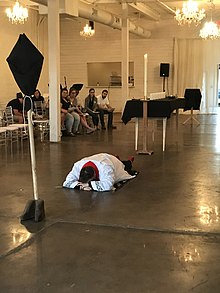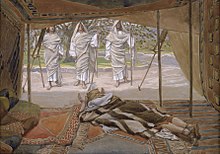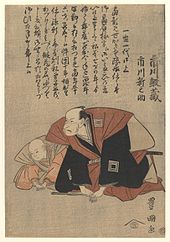Prostration


Prostration is the gesture of placing one's body in a reverentially or submissively prone position. Typically prostration is distinguished from the lesser acts of bowing or kneeling by involving a part of the body above the knee, especially the hands, touching the ground.
Major world religions employ prostration as an act of submissiveness or worship to a supreme being or other worshiped entity (i.e. God), as in the metanoia in Christian prayer used in the Eastern Orthodox and Oriental Orthodox Churches and the sujud of the Islamic prayer, salat.[1] In various cultures and traditions, prostrations are similarly used to show respect to rulers, civil authorities and social elders or superiors, as in the Chinese kowtow or Ancient Greek proskynesis. The act has often traditionally been an important part of religious, civil and traditional rituals and ceremonies, and remains in use in many cultures.
Traditional religious practices

Many religious institutions (listed alphabetically below) use prostrations to embody the lowering, submitting or relinquishing of the individual ego before a greater spiritual power or presence.
Baháʼí Faith
In the Baháʼí Faith, prostrations are performed as a part of one of the alternatives of obligatory prayer (the "Long" one)[2] and in the case of traveling, a prostration is performed in place of each missed obligatory prayer in addition to saying "Glorified be God, the Lord of Might and Majesty, of Grace and Bounty". However, if unable to do so, saying "Glorified be God" is sufficient.[3] There are specifics about where the prostration can take place including, "God hath granted you leave to prostrate yourselves on any surface that is clean ..." (note #10) and "He also condemns such practices as prostrating oneself before another person and other forms of behaviour that abase one individual in relation to another". (note #57)
Buddhism
In Buddhism, prostrations are commonly used and the various stages of the physical movement are traditionally counted in threes and related to the Triple Gem, consisting of:
- the Awakened One (Sanskrit/Pali: Buddha) (in this meaning, to own potential)
- his teaching (Sanskrit: Dharma; Pali: Dhamma)
- his community (Sangha) of noble disciples (ariya-savaka).[4]
In addition, different schools within Buddhism use prostrations in various ways, such as the Tibetan tantric preliminary practice of a 100,000 prostrations as a means of overcoming pride (see Ngöndro).[5] Tibetan pilgrims often progress by prostrating themselves fully at each step, then moving forward as they get up, in such a way that they have lain on their face on each part of their route. Each three paces involves a full prostration; the number three is taken to refer to the Triple Gem. This is often done round a stupa, and in an extremely arduous pilgrimage, Mount Kailash is circumnavigated entirely by this method, which takes about four weeks to complete the 52 kilometre route. It is also not unusual to see pilgrims prostrating all the way from their home to Lhasa, sometimes a distance of over 2000 km, the process taking up to two years to complete.
Christianity

In Oriental Orthodox Christianity and Western Orthodox Christianity, believers prostrate during the seven fixed prayer times; prayer rugs are used by some adherents to provide a clean space for believers to offer their Christian prayers to God, e.g. the canonical hours.[6][7] Oriental Orthodox Christians, such as Copts, incorporate prostrations in their prayers that are performed facing eastward in anticipation of the Second Coming of Jesus, "prostrating three times in the name of the Trinity; at the end of each Psalm … while saying the ‘Alleluia’; and multiple times" during the forty-one Kyrie eleisons" (cf. Agpeya).[6][1] Syriac Orthodox and Indian Orthodox Christians, as well as Christians belonging to the Mar Thoma Syrian Church (an Oriental Protestant denomination), make multiple prostrations at the seven fixed prayer times during which the canonical hours are prayed, thrice during the Qauma prayer, at the words "Crucified for us, Have mercy on us!", thrice during the recitation of the Nicene Creed at the words "And was incarnate of the Holy Spirit...", "And was crucified for us...", & "And on the third day rose again...", as well as thrice during the Prayer of the Cherubim while praying the words "Blessed is the glory of the Lord, from His place forever!" (cf. Shehimo).[8][9] Oriental Catholic and Oriental Protestant rites also use prostrations in a similar way as the Oriental Orthodox Churches.[10]
Among Old Ritualists, a prayer rug known as the Podruchnik is used to keep one's face and hands clean during prostrations, as these parts of the body are used to make the sign of the cross.[11]
The Roman Catholic, Lutheran, and Anglican Churches use full prostrations, lying flat on the floor face down, during the imposition of Holy Orders,[12] Religious Profession and the Consecration of Virgins. Additionally, in the Roman Catholic Church and United Methodist Church, at the beginning of the Good Friday Liturgy, the celebrating priest and the deacon[13] prostrate themselves in front of the altar. Dominican practice on Good Friday services in priory churches includes prostration by all friars in the aisle of the church. In the Roman Catholic, Lutheran and Anglican churches, partial prostrations ("profound bows") can be used in place of genuflections for those who are unable to genuflect. The prostration is always performed before God, and in the case of holy orders, profession or consecration the candidates prostrate themselves in front of the altar which is a symbol of Christ.

In Eastern Orthodox (Byzantine Rite) worship, prostrations are preceded by making the sign of the cross and consist of kneeling and touching the head to the floor. They are commonly performed both at specific moments during the services and when venerating relics or icons. However, prostrations are forbidden on the Lord's Day (Sunday) and during Paschaltide (Easter season) in honour of the Resurrection[14] and are traditionally discouraged on Great Feasts of the Lord. During Great Lent, and Holy Week, frequent prostrations are prescribed (see Prayer of St. Ephraim). Orthodox Christian may also make prostrations in front of people (though in this case without the Sign of the Cross, as it is not an act of veneration or divine worship), such as the bishop, one's spiritual father or one another when asking forgiveness (in particular at the Vespers service which begins Great Lent on the afternoon of the Sunday of Forgiveness.) Those who are physically unable to make full prostrations may instead substitute metanias (bows at the waist).
Hinduism
In Hinduism, eight-limbed (ashtanga pranama, also called dandavat, meaning "like a stick") and five-limbed (panchanga pranama) prostrations are included in the religious ritual of puja.
Islam

In Islam, prostrations (sajadat, plural of sujud or sajda) are used to praise, glorify and humble oneself in front of Allah (The God), and are a vital part of the five obligatory prayers performed daily; this is deemed obligatory for every Muslim whether the prayers are being performed individually or in the congregation.[15][16][17] Additionally, the thirty-second chapter (sura) of the Qur'an is titled As-Sajdah ("The Prostration": see 32:1 (Translated by Yusuf Ali)), while the Arabic word sujud (also meaning prostration) appears about 90 times in the Qur'an, a fact which many Muslim scholars claim to be another example of its significance in Islam.[17]
According to a traditional account of the words and deeds of Muhammad as contained in the collection of hadith of Ibn Majah, Muhammad is reported to have said that "The prayer [salah] is a cure for many diseases" and have advised people to perform prostration gracefully.[16]
It is also important to note that in Islam, the prostration of anyone but Allah is absolutely forbidden. Muhammad strictly prohibited Muslims from prostrating before him. Regardless of the circumstances, no Muslim should request or accept prostration from others, as prostration of anyone but Allah is strictly prohibited in Islam.
Jainism
In Jainism, there is a great importance placed on prostration, especially when a devotee is in the temples or in front of high souls.[clarification needed] It represents the surrendering of ego.
Judaism

In Judaism, the Tanakh and Talmudic texts as well as writings of Gaonim and Rishonim indicate that prostration was very common among Jewish communities until some point during the Middle Ages. In Mishneh Torah, Maimonides states full prostration (with one's body pressed flat to the earth) should be practiced at the end of the Amidah, recited thrice daily. Members of the Karaite denomination practice full prostrations during prayers. Traditionally, Orthodox Ashkenazi Jews prostrated during Rosh Hashana and Yom Kippur, as did Yemenite Jews during the Tachanun part of daily Jewish prayer. Ethiopian Jews traditionally prostrated during a holiday specific to their community known as Sigd. Sigd comes from a root word meaning prostration in Ge'ez, Aramaic, and Arabic. There is a movement among Talmide haRambam to revive prostration as a regular part of daily Jewish worship.
Rabbinical Judaism teaches that when the High Priest spoke the Tetragrammaton in the Holy of Holies of the Temple in Jerusalem on Yom Kippur, the people in the courtyard were to prostrate themselves completely as they heard the name spoken aloud.
Judaism forbids prostration directly on a stone surface in order to prevent conflation with similar practices of Canaanite polytheists.[18]
Sikhism
Sikhs prostrate in front of Guru Granth Sahib, the holy scripture of the Sikhs. Sikhs consider Guru Granth Sahib as their living Guru and the unchanging word of God: thus, by prostrating, Sikhs present their head to their Guru, awaiting command, which is taken in the form of a hukamnama, or a random opening of Guru Granth Sahib to reveal an edict for the individual or congregation (similar to the ancient Roman practice of sortes sanctorum, a form of bibliomancy). Sikhs call the prostration mutha tekna ("lowering the forehead"). Whenever and however many times a Sikh is in the presence of Guru Granth Sahib he will prostrate, usually upon the initial sight of Guru Granth Sahib and again upon leaving the presence of Guru Granth Sahib. Sikhs, in their personal worship (morning Nitnem and evening Rehras), will prostrate upon the completion of prayers and the ardās. The direction of prostration is not important as Sikhs place emphasis on the omnipresence of God: however, if it is possible, Sikhs tend to prostrate in the direction in which bani (books containing the word of God, such as the Gutka Sahib or Pothi Sahib) are kept. Other prostrations practiced by Sikhs from an Indian culture are touching of the feet to show respect and great humility (generally done to grandparents and other family elders). Full prostration is reserved for Guru Granth Sahib, as prostration is considered to be the ultimate act of physical humility and veneration.
Other contexts

Outside of traditional religious institutions, prostrations are used to show deference to worldly power, in the pursuit general spiritual advancement and as part of a physical-health regimen.
Hawaii
In ancient Hawaii, a form of prostration known as kapu moe required all to prostrate in the presence of a nīʻaupiʻo or a piʻo chief on the pain of death. The only people exempt from this were chiefs of the next grade the naha and wohi chiefs who were required to sit in their presence. Other Polynesian groups are known to practice this.
Imperial China
In Imperial China, a form of prostration known as a kowtow or kētou was used as a sign of respect and reverence.
Japan

In Japan, a common form of prostration is called dogeza, which was used as a sign of deep respect and submission for the elders of a family, guests, samurai, daimyōs and the Emperor. In modern times, it is generally used only in extreme circumstances, such as when apologizing for very serious transgressions or begging for an incredible favor.
To perform dogeza, a person first enters the sitting/kneeling position known as seiza, and then proceeds to touch the head to the ground. This practice may be related to rites of the Shinto religion and culture of Japan dating back centuries.
Martial arts
Shugyo in martial arts, particularly in the Shōtōkai and Kyokushin styles of Karate, it is a form of extreme spiritual discipline.
Yoga
In modern yoga practice, "sun salutations" (sūrya namaskāra) are a regular part of practitioners' routines. Such a practice may be used for both maintaining physical well-being and spiritual attainment.
Yoruba Ìdọ̀bálẹ̀ and Ìkúnlẹ̀
In traditional and contemporary Yoruba culture, younger male family and community members greet elders by assuming a position called "ìdọ̀bálẹ̀". The traditional, full Yoruba prostration involves the prostrator lying down almost prone with his feet extended behind his torso while the rest of his weight is propped up on both hands. This traditional form is being replaced by a more informal bow and touching the fingertips to the floor in front of an elder with one hand, while bending slightly at the knee. The female form of the greeting is the "ìkúnlẹ̀", a form of kneeling where the younger party bows to one or both knees in front of an elder relative or community member. Both gestures are widely practiced; to not perform them would be considered ill-mannered.
Modified versions of both greetings are also common in traditional Yoruba religious and cultural contexts in the African diaspora, particularly in Brazil and Cuba.
See also
Notes and references
- ^ a b Dawood, Bishoy (8 December 2013). "Stand, Bow, Prostrate: The Prayerful Body of Coptic Christianity : Clarion Review". Clarion Review. Retrieved 27 July 2020.
- ^ Bill Washington (1996). "Some Passing Comments on the Long Obligatory Prayer of Bahá'u'lláh". Baháʼí Studies in Australasia. 3. Association for Baháʼí Studies Australia. Retrieved 30 September 2015.
- ^ Source: The Kitab-i-Aqdas, The Most Holy Book, by Baha'u'llah, #14.
- ^ For an example of how this reverence for the Triple Gem is embodied in the Pali Canon, see, e.g., the Ratana Sutta.
- ^ See the "Namo Buddha Glossary of Buddhist Terminology," entry "four special foundations" ("Namo Buddha Glossary of Buddhist Terminology". Archived from the original on 7 June 2021. Retrieved 3 September 2008.).
- ^ a b Kosloski, Philip (16 October 2017). "Did you know Muslims pray in a similar way to some Christians?". Aleteia. Retrieved 25 July 2020.
- ^ Bishop Brian J Kennedy, OSB. "Importance of the Prayer Rug". St. Finian Orthodox Abbey. Archived from the original on 25 July 2020. Retrieved 25 July 2020.
- ^ Shehimo: Book of Common Prayer. Diocese of South-West America of the Malankara Orthodox Syrian Church. 2016. p. 5, 7, 12.
- ^ Richards, William Joseph (1908). The Indian Christians of St. Thomas: Otherwise Called the Syrian Christians of Malabar: a Sketch of Their History and an Account of Their Present Condition as Well as a Discussion of the Legend of St. Thomas. Bemrose. p. 99.
- ^ Landy, Thomas M. (11 February 2014). "Syro-Malabar Catholics worship eastward". Catholics & Cultures. Retrieved 21 August 2020.
At Syro-Malabar liturgies, men and women generally separate into different sides of the church. Shoes are left outside of church, and prayer rugs cover the floor.
- ^ Basenkov, Vladimir (10 June 2017). "Vladimir Basenkov. Getting To Know the Old Believers: How We Pray". Orthodox Christianity. Retrieved 25 July 2020.
- ^ Latona, Mike (1 August 2022). "Prostration a powerful moment in ordination rites". Catholic Courier. Retrieved 12 August 2022.
- ^ 2011 Roman Missal, [Good Friday] paragraph 5
- ^ Canon 20 of the 1st Ecumenical Council, Canon 90 of the 6th Ecumenical Council, Canon 91 of St Basil
- ^ "How to Perform Salaah" (PDF). Archived from the original (PDF) on 25 February 2009.
- ^ a b The Medical Advantages of Sajdah[permanent dead link]- by Dr. Muhammad Karim Beebani
- ^ a b "Benefits of Salah". www.islamawareness.net.
- ^ "Do Jews Kneel in Prayer?". www.chabad.org.
